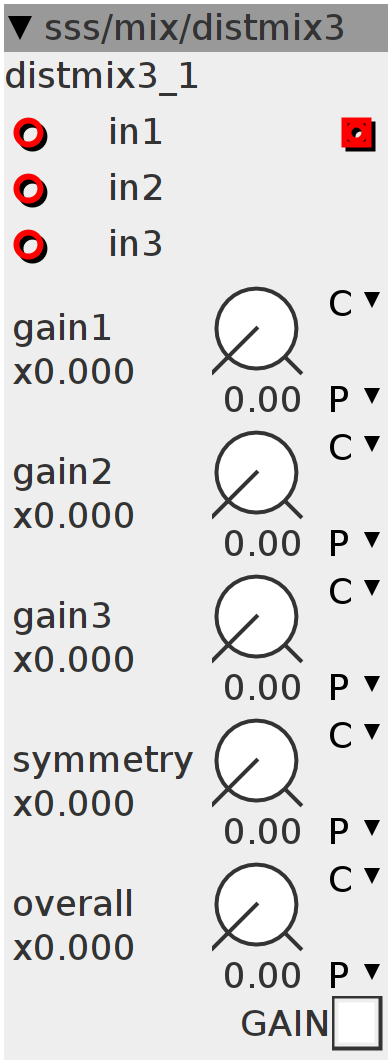distmix3
3 channel 2 stage distorting mixer. The volume of each input is controlled at the first stage adding individual distortion based on the strength of the respective input plus the (mix)value of the second stage. The second stage then sums the three channels and applies it's own distortion when the signal becomes hot. For a very aggressive distortion, add a second module and connect the output of the first to all three inputs of the second. When applying a loud basskick at one of the inputs and a less loud bass, the mixer will tend to duck the bass,
Inlets
frac32buffer in1
frac32buffer in2
frac32buffer in3
Outlets
frac32buffer out
Parameters
bool32.tgl GAIN
frac32.u.map.gain16 gain1
frac32.u.map.gain16 gain2
frac32.u.map.gain16 gain3
frac32.u.map.gain symmetry
frac32.u.map.gain overall
int32_t val[4];
int32_t v27 = 1 << 27;
int32_t v30 = 1 << 30;
int32_t hp[4];
int32_t symmetry;
int32_t clamp(int32_t in, int I) {
hp[I] += val[I] - hp[I] >> 10;
val[I] -= hp[I];
int32_t damp;
int32_t ABS = __SSAT(val[I] + val[3] >> 1, 28);
ABS = ___SMMUL(ABS, ABS) << 5;
ABS = ___SMMUL(ABS, ABS) << 5;
ABS = ___SMMUL(ABS, ABS) << 5;
MTOF(v27 - (ABS << 2) -
(val[I] < 0 ? ___SMMUL(__USAT(ABS, 24), symmetry) << 6 : 0) *
(I > 2 ? -1 : 1),
damp)
damp = (val[I] > 0 ? val[I] : -val[I]) > (in > 0 ? in : -in)
? (uint32_t)v30 + damp >> 1
: damp;
val[I] += ___SMMUL((in - val[I]), damp) << 1;
}symmetry = param_symmetry;clamp(__SSAT(___SMMUL(__SSAT(inlet_in1, 28) << 1, param_gain1), 28), 0);
clamp(__SSAT(___SMMUL(__SSAT(inlet_in2, 28) << 1, param_gain2), 28), 1);
clamp(__SSAT(___SMMUL(__SSAT(inlet_in3, 28) << 1, param_gain3), 28), 2);
clamp(__SSAT(___SMMUL(__SSAT(val[0] + val[1] + val[2], 28) << 1, param_overall),
28),
3);
outlet_out = val[3] >> 1 - param_GAIN;